OK OÖ Kulturquartier
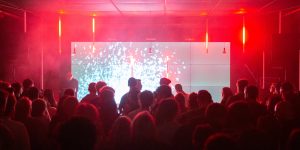
OK Night
The OK Night, much appreciated by music enthusiasts and night-owls, is the place to be on the Festival Saturday for everyone who wants to crank it up after the Electronic Theatre or the Klangwolke.
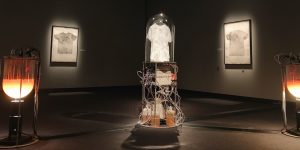
CyberArts Opening
Highlights of Digital Media Art! Opening of the CyberArts exhibition in the OÖ Kulturquartier. Since 1998 the OK in the OÖ Kulturquartier has presented the prizewinning art works of the Prix Ars Electronica, the most renowned competition for digital art in the world.
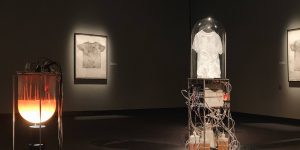
CyberArts 2019 Tour
Join the tour through the Cyberarts exhibition in the Ursulinenhof in OÖ Kulturquartier that showcases works singled out for recognition by the Prix Ars Electronica.

Solar Walk
Réka Bucsi (HU)
Solar Walk shows the journey of individuals and their creations on through time and space. Any meaning behind the actions only exists from the viewpoint of the individual but not from the perspective of an entire solar system. Réka Bucsi conveys in her whimsical animation the melancholy acceptance of chaos as something beautiful and cosmic.

The SINE WAVE ORCHESTRA stay
Ken Furudate (JP), Daisuke Ishida (JP), Kazuhiro Jo (JP), Zuiki Noguchi (JP) / The SINE WAVE ORCHESTRA (JP)
The SINE WAVE ORCHESTRA has chosen to dedicate their work to the sine wave, said to be the most basic sound and therefore called pure tone, containing neither overtone nor noise but a single frequency. This work is defined by the interplay of visitors: Each spectator is given a small device which can play a sine wave and asked to choose its frequency and position on one of the columns of copper wire in the attic.
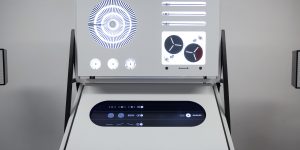
APPARATUM
panGenerator (PL)
Digital interface meets purely analogue sound. The APPARATUM was inspired by the heritage of the Polish Radio Experimental Studio — one of the first studios in the world to produce electroacoustic music. The installation draws inspiration musically and graphically from the “Symphony – Electronic Music” composed by Bogusław Schaeffer. Here, analogue sound generators, based on magnetic tape and optical components, are controlled via a graphic score with a digital interface. NOTE: You can create and listen to your own composition, print out your score and retrieve it in the online archive of APPARATUM.
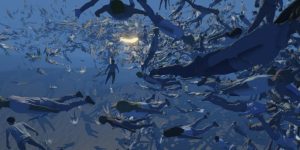
Emergence
Universal Everything (GB)
Emergence is an open-world environment and crowd performance. The virtual reality installation expresses the primal human desire to maintain individual identity while being part of a crowd. As the user navigates a crowd of thousands, shafts of light beckon them closer. As they touch the light, the environment responds in real time, continually challenging the user's perception. In this installation, Universal Everything experiments with software-based improvisation and custom-coded crowd simulations.
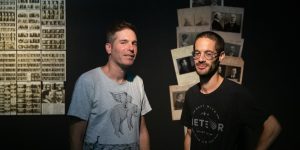
The Normalizing Machine
Dan Stavy (IL), Eran Weissenstern (IL), Mushon Zer-Aviv (IL)
The Normalizing Machine aims to identify and analyze the image of social normalcy. Facing the camera, each participant is asked to point out who looks “more normal” from a line-up of previously recorded participants. The machine adds the selection to its aggregated algorithmic image of normalcy.

VFRAME: Visual Forensics and Metadata Extraction
Adam Harvey (US), Josh Labouve (US)
In conflict zones around the world, serious human rights violations repeatedly occur through the use of illegal munitions. VFRAME shows how surveillance technologies can be used to document such violations – for example in the Syrian conflict. A visual search engine was trained to analyze video data sets from battle zones to spot such weapons. In order to train the neural network of the search engine to recognize them even in low-resolution recordings, 3D models were created and fed into the object detection software.
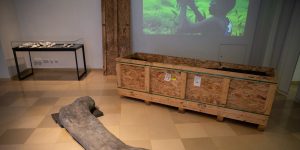
Fossil Futures
Nora Al-Badri (DE), Jan Nikolai Nelles (DE)
"Oskar" is what Germans affectionately call "their" Dino, the world's largest dinosaur skeleton, which is at home in Berlin's Museum of Natural History. Nora Al-Badri and Jan Nikolai Nelles tried to find out where it originally came from and how it finally landed here. They received little information from the public authorities, but with the help of leaked data, artificial intelligence and 3D scans, the history of the fossil could be reconstructed. The trail led to the south of Tanzania. Under German colonial rule, tons of petrified bones were found there and brought to Germany. Using state-of-the-art technology – including a "Virtual Reality Museum" – Fossil Future poses the question of stolen identity, cultural heritage and public property.


